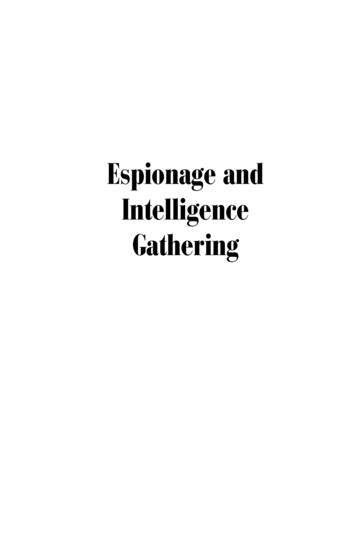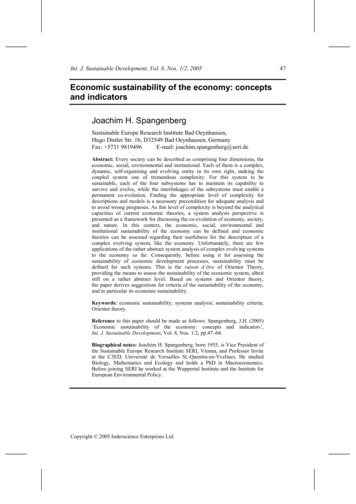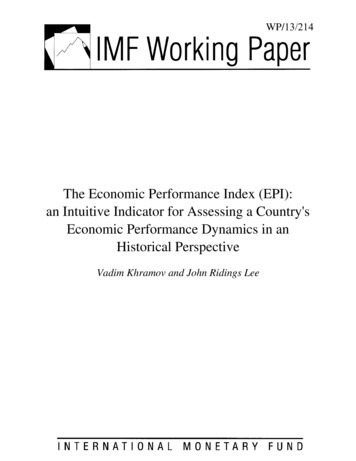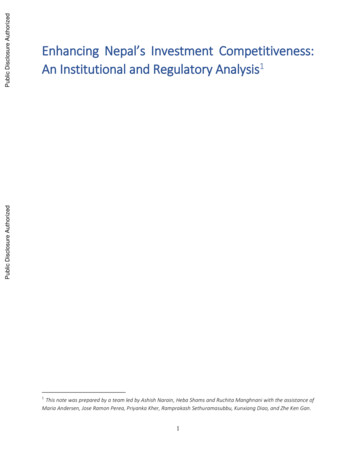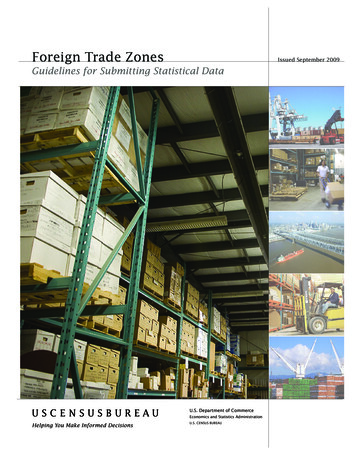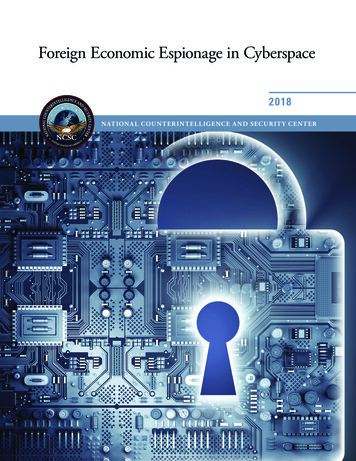
Transcription
Foreign Economic Espionage in Cyberspace2018NAT IONA L COU N T ER I N T E L L IGE NC E A N D SECU R IT Y C E N T ER
ContentsExecutive Summary 1Scope Note 2I. The Strategic Threat of Cyber Economic Espionage 4II. Threats from Foreign Countries 5China: Persistent Cyber Activities 5Russia: A Sophisticated Adversary 8Iran: An Increasing Cyber Threat 9Targeted Technologies 11III. Emerging Threats 12Software Supply Chain Operations 13Foreign Laws Could Enable Intellectual Property Theft 13Foreign Technology Companies With Links to Host Governments 14Annex – Decreasing the Prevalence of Economic or IndustrialEspionage in Cyberspace 15
Executive SummaryIn the 2011 report to Congress on Foreign Spies Stealing U.S. Economic Secrets in Cyberspace,the Office of the National Counterintelligence Executive provided a baseline assessment of themany dangers facing the U.S. research, development, and manufacturing sectors when operating incyberspace, the pervasive threats posed by foreign intelligence services and other threat actors, andthe industries and technologies most likely at risk of espionage. The 2018 report provides additionalinsight into the most pervasive nation-state threats, and it includes a detailed breakout of theindustrial sectors and technologies judged to be of highest interest to threat actors. It also discussesseveral potentially disruptive threat trends that warrant close attention.This report focuses on the following issuesForeign economic and industrial espionage against the United States continues to represent a significantthreat to America’s prosperity, security, and competitive advantage. Cyberspace remains a preferredoperational domain for a wide range of industrial espionage threat actors, from adversarial nationstates, to commercial enterprises operating under state influence, to sponsored activities conductedby proxy hacker groups. Next-generation technologies, such as Artificial Intelligence (AI) and theInternet-of-Things (IoT) will introduce new vulnerabilities to U.S. networks for which the cybersecurity community remains largely unprepared. Building an effective response will require understandingeconomic espionage as a worldwide, multi-vector threat to the integrity of the U.S. economy andglobal trade.Foreign intelligence services—and threat actors working on their behalf—continue to represent the mostpersistent and pervasive cyber intelligence threat. China, Russia, and Iran stand out as three of themost capable and active cyber actors tied to economic espionage and the potential theft of U.S. tradesecrets and proprietary information. Countries with closer ties to the United States also have conducted cyber espionage to obtain U.S. technology. Despite advances in cybersecurity, cyber espionage continues to offer threat actors a relatively low-cost, high-yield avenue of approach to a widespectrum of intellectual property.A range of potentially disruptive threat trends warrant attention. Software supply chain infiltration alreadythreatens the critical infrastructure sector and is poised to threaten other sectors. Meanwhile, newforeign laws and increased risks posed by foreign technology companies due to their ties to host governments, may present U.S. companies with previously unforeseen threats.Cyber economic espionage is but one facet of the much larger, global economic espionage challenge.We look forward to engaging in the larger public discourse on mitigating the national economic harmcaused by these threats.1
Scope NoteThis report is submitted in compliance with the National Defense Authorization Act for Fiscal Year2015, Section 1637, which requires that the President annually submit to Congress a report on foreigneconomic espionage and industrial espionage in cyberspace during the 12-month period precedingthe submission of the report.Definitions of Key TermsFor the purpose of this report, key terms were defined according to definitions provided in Section1637 of the National Defense Authorization Act for Fiscal Year 2015.Economic or Industrial Espionage means (a) stealing a trade secret or proprietary information orappropriating, taking, carrying away, or concealing, or by fraud, artifice, or deception obtaining, atrade secret or proprietary information without the authorization of the owner of the trade secret orproprietary information; (b) copying, duplicating, downloading, uploading, destroying, transmitting,delivering, sending, communicating, or conveying a trade secret or proprietary information without the authorization of the owner of the trade secret or proprietary information; or (c) knowinglyreceiving, buying, or possessing a trade secret or proprietary information that has been stolen orappropriated, obtained, or converted without the authorization of the owner of the trade secret orproprietary information.Cyberspace means (a) the interdependent network of information technology infrastructures; and (b)includes the Internet, telecommunications networks, computer systems, and embeddedprocessors and controllers.ContributorsThe National Counterintelligence and Security Center (NCSC) compiled this report, with close support from the Cyber Threat Intelligence Integration Center (CTIIC), and with input and coordinationfrom many U.S. Government organizations, including the Central Intelligence Agency (CIA), DefenseCyber Crime Center (DC3), Defense Intelligence Agency (DIA), Defense Security Service (DSS),Department of Energy (DoE), Department of Defense (DoD), Department of Homeland Security(DHS), Department of State (DoS), Department of Treasury (Treasury), Federal Bureau of Investigation (FBI), National Cyber Investigative Joint Task Force (NCIJTF), National Geospatial-IntelligenceAgency (NGA), National Reconnaissance Office (NRO), National Security Agency (NSA), and Officeof the Director of National Intelligence (ODNI).2
3
I. The Strategic Threat of Cyber Economic EspionageForeign economic and industrial espionage against the United States continues to representa significant threat to America’s prosperity, security, and competitive advantage. Cyberspaceremains a preferred operational domain for a wide range of industrial espionage threat actors, fromadversarial nation-states, to commercial enterprises operating under state influence, to sponsoredactivities conducted by proxy hacker groups. Next-generation technologies such as ArtificialIntelligence (AI) and the Internet-of-Things (IoT) will introduce new vulnerabilities to U.S. networksfor which the cybersecurity community remains largely unprepared. Building an effective responsedemands understanding economic espionage as a worldwide, multi-vector threat to the integrity ofthe U.S. economy and global trade.The United States remains a global center for research, development, and innovation across multiplehigh-technology sectors. Federal research institutions, universities, and corporations are regularlytargeted by online actors seeking all manner of proprietary information and the overall long-termtrend remains worrisome.While next generation technologies will introduce a range of qualitative advances in data storage,analytics, and computational capacity, they also present potential vulnerabilities for which thecybersecurity community remains largely unprepared. The solidification of cloud computing over thepast decade as a global information industry standard, coupled with the deployment of technologiessuch as AI and IoT, will introduce unforeseen vulnerabilities to U.S. networks. Cloud networks and IoT infrastructureare rapidly expanding the global onlineoperational space. Threat actors havealready demonstrated how cloud can beused as a platform for cyber exploitation.As IoT and AI applications expand toempower everything from “smart homes”to “smart cities”, billions of potentiallyunsecured network nodes will create anincalculably larger exploitation space forcyber threat actors. Lack of industry standardization duringthis pivotal first-generation deploymentperiod will likely hamper the developmentof comprehensive security solutions in thenear-term. Building an effective response demandsunderstanding economic espionageas a worldwide, multi-vector threat tothe integrity of both the U.S. economyand global trade. Whereas cyberspaceis a preferred operational domain foreconomic espionage, it is but one ofmany. Sophisticated threat actors, such asadversarial nation-states, combine cyberexploitation with supply chain operations,human recruitment, and the acquisitionof knowledge by foreign students in U.S.universities, as part of a strategic technologyacquisition program.4
II. Threats from Foreign CountriesForeign intelligence services—and threat actors working on their behalf—continue to represent themost persistent and pervasive cyber intelligence threat. China, Russia, and Iran stand out as threeof the most capable and active cyber actors tied to economic espionage and the potential theft ofU.S. trade secrets and proprietary information. Countries with closer ties to the United States havealso conducted cyber espionage to obtain U.S. technology. Despite advances in cybersecurity, cyberespionage continues to offer threat actors a relatively low-cost, high-yield avenue of approach to awide spectrum of intellectual property.We anticipate that China, Russia, and Iran will remain aggressive and capable collectors of sensitiveU.S. economic information and technologies, particularly in cyberspace. All will almost certainlycontinue to deploy significant resources and a wide array of tactics to acquire intellectual propertyand proprietary information.Countries with closer ties to the United States have conducted cyber espionage and other forms ofintelligence collection to obtain U.S. technology, intellectual property, trade secrets, and proprietaryinformation. U.S. allies or partners often take advantage of the access they enjoy to collect sensitivemilitary and civilian technologies and to acquire know-how in priority sectors.China: Persistent Cyber ActivitiesChina has expansive efforts in place to acquire U.S. technology to include sensitive tradesecrets and proprietary information. It continues to use cyber espionage to support its strategicdevelopment goals—science and technology advancement, military modernization, and economicpolicy objectives. China's cyberspace operations are part of a complex, multipronged technologydevelopment strategy that uses licit and illicit methods to achieve its goals. Chinese companies andindividuals often acquire U.S. technology for commercial and scientific purposes. At the same time,the Chinese government seeks to enhance its collection of U.S. technology by enlisting the supportof a broad range of actors spread throughout its government and industrial base.5
UNCLASSIFIED//FOR OFFICIAL USE ONLYNational Intelligence CouncilApril 13, 2017(U) China’s Technology Development Strategy(U) China’s Technology Development StrategyChina's Strategic GoalsUNCLASSIFIED//FOR OFFICIAL USE ONLYUNCLASSIFIED//FOR OFFICIAL USE ONLYLegal andRegulatoryEnvironmentLegal rehensive National ollaborationsFrontCompaniesM&AM&AJoint Ventures (JV)ResearchPartnershipsInnovation DrivenMilitaryModernizationEconomicGrowth ModelMilitary ModernizationNon-Traditional CollectorsResearchPartnershipsInnovation DrivenComprehensiveNationalPowerEconomic GrowthModelRecruitmentProgramsJoint Ventures (JV)JointVenturesSTRATEGIC l sChina uses individuals for whom science or business is their primary profession to target andacquireUSusestechnology.Chinaindividuals for whom science or business is their primary profession to target andacquireChinauses USJVstechnology.to acquire technology and technical know-how.China uses JVs to acquire technology and technical know-how.China actively seeks partnerships with government laboratories-such as the Department of EnergyResearch partnershipslabs-tolearnaboutand partnershipsacquire specificthe soft skillsasnecessaryto run government andlaboratories-suchthe DepartmentEnergyResearch partnershipslabs-toabout and acquirespecific technology,and the soft skillsnecessaryto run researchsuch facilities.Chinauseslearncollaborationsand relationshipswith universitiesto acquirespecificandusesand relationshipsuniversitiesto acquireandgainChinaaccessto collaborationshigh-end researchequipment. withIts policiesstateit shouldspecificexploitresearchthe opennessAcademic Collaborationsgain accessto high-endresearch equipment.Its policies state it should exploit the opennessAcademic Collaborations of academiato fillChina’s strategicgaps.of academia to fill China’s strategic gaps.S&T InvestmentsChina has sustained, long-term state investments in its S&T infrastructure.M&A M&AChina seeks to buy companies that have technology, facilities and people. These sometimesChina seeks to buy companies that have technology, facilities and people. These sometimesend endup ases.upCommitteeas CommitteeForeignInvestmentininthethe UnitedUnited StatesS&T InvestmentsFront CompaniesFront CompaniesChina has sustained, long-term state investments in its S&T sobscurethethehandhandofof thethe ChineseChinese lledtechnology.Chinausesits toChinaChinaandworkChinausesits talentrecruitmentprogramstotofindfind foreignforeign itmentProgramson keystrategicprograms.on nceServicesand RegulatoryLegal Legaland RegulatoryEnvironmentEnvironmentMinistryof nceintelligence officesThe TheMinistryof yacquisitionefforts.Chinausesits lawsandregulationstotodisadvantagedisadvantage foreignforeign companiesitsitsChinausesits ecompanies.ownowncompanies.NIC 1704-00011NIC 1704-00011UNCLASSIFIED//FOR OFFICIAL USE ONLYUNCLASSIFIED//FOR OFFICIAL USE ONLY6
The Intelligence Community and private sector security experts continue to identify ongoingChinese cyber activity, although at lower volumes than existed before the bilateral September2015 U.S.-China cyber commitments. Most Chinese cyber operations against U.S. private industrythat have been detected are focused on cleared defense contractors or IT and communicationsfirms whose products and services support government and private sector networks worldwide.Examples of identified ongoing Chinese cyber activity include the following: According to several cyber intelligencecompanies, in 2017 the China-associatedcyber espionage group APT10 continuedwidespread operations to target engineering,telecommunications, and aerospaceindustries. APT10 targeted companiesacross the globe, including the United States,using its exploitation of managed ITservice providers as a means to conductsuch operations. Cybersecurity researchers have foundlinks between Chinese cyber actorsand a back door in the popular CCleanerapplication that allowed the actors to targetU.S. companies, including Google,Microsoft, Intel, and VMware. In November 2017, PricewaterhouseCoopers(PWC) reported that the China-based APT,known as KeyBoy, was shifting its focus totarget Western organizations. According toPWC, the targeting likely was for corporateespionage purposes. KeyBoy previouslyfocused on Asian targets, according tocommercial cybersecurity reporting. According to FireEye, in 2017 TEMP.Periscopecontinued targeting the maritime industryas well as engineering-focused entitiesincluding research institutes, academicorganizations, and private firms in the UnitedStates. FireEye has detected sharp increasesin targeting in early 2018 as well.Recent Unsealed U.S. Indictment With a Link to ChinaIn November 2017, Wu Yingzhuo, Dong Hao and Xia Lei, Chinese nationals and residents ofChina, were charged with computer hacking, theft of trade secrets, conspiracy, and identitytheft. These efforts were directed at U.S. and foreign employees and the computers ofthree corporations that were victims in the financial, engineering, and technology industriesbetween 2011 and May 2017.We believe that China will continue to be a threat to U.S. proprietary technology and intellectualproperty through cyber-enabled means or other methods. If this threat is not addressed, it coulderode America’s long-term competitive economic advantage.7
Russia: A Sophisticated AdversaryThe threat to U.S. technology from Russia will continue over the coming years as Moscow attemptsto bolster an economy struggling with endemic corruption, state control, and a loss of talentdeparting for jobs abroad. Moscow’s military modernization efforts also likely will be a motivatingfactor for Russia to steal U.S. intellectual property. An aggressive and capable collector of sensitiveU.S. technologies, Russia uses cyberspace as one of many methods for obtaining the necessaryknow-how and technology to grow and modernize its economy. Other methods include the following: Use of Russian commercial and academicenterprises that interact with the West; Recruitment of Russian immigrants withadvanced technical skills by the Russianintelligence services; and Russian intelligence penetration of publicand private enterprises, which enable thegovernment to obtain sensitive technicalinformation from industry.Russia uses cyber operations as an instrument of intelligence collection to inform its decisionmaking and benefit its economic interests. Experts contend that Russia needs to enact structuralreforms, including economic diversification into sectors such as technology, to achieve the higherrate of gross domestic product growth publicly called for by Russian President Putin. In supportof that goal, Russian intelligence services have conducted sophisticated and large-scale hackingoperations to collect sensitive U.S. business and technology information. In addition, Moscow usesa range of other intelligence collection operations to steal valuable economic data: In 2016, the hacker “Eas7” confided toWestern press that she had collaboratedwith the Russian Federal Security Service(FSB) on economic espionage missions. Sheestimated that “among the good hackers,at least half works (sic) for governmentstructures,” suggesting Moscow employscyber criminals as a way to make suchoperations plausibly deniable.Moscow has used cyber operations tocollect intellectual property data fromU.S. energy, healthcare, and technologycompanies. For example, RussianGovernment hackers last year compromiseddozens of U.S. energy firms, including theiroperational networks. This activity couldbe driven by multiple objectives, includingcollecting intelligence, developing accessesfor disruptive purposes, and providingsensitive U.S. intellectual property toRussian companies. Since at least 2007, the Russian statesponsored cyber program APT28 hasroutinely collected intelligence on defenseand geopolitical issues, including thoserelating to the United States and WesternEurope. Obtaining sensitive U.S. defenseindustry data could provide Moscow witheconomic (e.g. in foreign military sales) andsecurity advantages as Russia continues tostrengthen and modernize its military forces.8
Recent Unsealed U.S. Indictment with a Link to RussiaIn March 2017, the United States Department of Justice indicted two FSB officials and theirRussian cybercriminal conspirators on computer hacking and conspiracy charges relatedto the collection of emails of U.S. and European employees of transportation and financialservices firms. The charges included conspiring to engage in economic espionage and theftof trade secrets.We believe that Russia will continue to conduct aggressive cyber operations during the next yearagainst the United States and its allies as part of a global intelligence collection program focusedon furthering its security interests. Although cyber operations are just one element of Russia'smultipronged approach to information collection, they give Russia's intelligence services a moreagile and cost-efficient tool to accomplish Moscow's objectives. Indeed, Russian cyber actors arecontinuing to develop their cyber tradecraft—such as using open-source hacking tools that minimizeforensic connections to Russia.Iran: An Increasing Cyber ThreatIranian cyber activities are often focused on Middle Eastern adversaries, such as Saudi Arabia andIsrael; however, in 2017 Iran also targeted U.S. networks. A subset of this Iranian cyber activityaggressively targeted U.S. technologies with high value to the Iranian government. The loss ofsensitive information and technologies not only presents a significant threat to U.S. national security.It also enables Tehran to develop advanced technologies to boost domestic economic growth,modernize its military forces, and increase its foreign sales. Examples of recent Iranian cyberactivities include the following: 9The Iranian hacker group Rocket Kittenconsistently targets U.S. defense firms,likely enabling Tehran to improve its alreadyrobust missile and space programswith proprietary and sensitive U.S.military technology.Iranian hackers target U.S. aerospaceand civil aviation firms by using variouswebsite exploitation, spearphishing,credential harvesting, and socialengineering techniques. The OilRig hacker group, which historicallyfocuses on Saudi Arabia, has increased itstargeting of U.S. financial institutions andinformation technology companies. The Iranian hacker group APT33 hastargeted energy sector companies as partof Iran’s national priorities for improving itspetrochemical production and technology. Iranian hackers have targeted U.S. academicinstitutions, stealing valuable intellectualproperty and data.
Recent Unsealed U.S. Indictments with a Link to IranIn July 2017, Iranian nationals Mohammed Reza Rezakhah and Mohammed Saeed Ajily werecharged with hacking into U.S. software companies, stealing their proprietary software, andselling the stolen software to Iranian universities, military and government entities, and otherbuyers outside of the United States.In November 2017, Iranian national Behzad Mesri was charged with allegedly hacking HBO’scorporate systems, stealing intellectual property and proprietary data, to include scripts andplot summaries for unaired episodes. Mesri had previously hacked computer systems for theIranian military and has been a member of an Iran-based hacking group called the Turk BlackHat security team.In March 2018, nine Iranian hackers associated with the Mabna Institute were chargedwith stealing intellectual property from more than 144 U.S. universities which spentapproximately 3.4 billion to procure and access the data. The data was stolen at the behestof Iran’s Islamic Revolutionary Guard Corps and used to benefit the government of Iranand other Iranian customers, including Iranian universities. Mabna Institute actors alsotargeted and compromised 36 U.S. businesses.We believe that Iran will continue working to penetrate U.S. networks for economic or industrialespionage purposes. Iran’s economy—still driven heavily by petroleum revenue—will dependon growth in nonoil industries and we expect Iran will continue to exploit cyberspace to gainadvantages in these industries. Iran will remain committed to using its cyber capabilities to attainkey economic goals, primarily by continuing to steal intellectual property, in an effort to narrow thescience and technology gap between Iran and Western countries.10
Targeted TechnologiesAlthough many aspects of U.S. economic activity and technology are of potential interest to foreignintelligence collectors, we judge that the highest interest is in the following areas:Industry11Priority Sectors / TechnologiesEnergy /Alternative Energy Advanced pressurized water reactorand high-temperature, gas-coolednuclear power stations Biofuels Energy-efficient industries Oil, gas, and coalbed methane development,including fracking Smart grids Solar energy technology Wind turbinesBiotechnology Advanced medical devices Biomanufacturing and chemicalmanufacturing Biomaterials Biopharmaceuticals Genetically modified organisms Infectious disease treatment New vaccines and drugsDefenseTechnology Aerospace & Aeronautic Systems Armaments Marine Systems Radar OpticsEnvironmentalProtection Batteries Energy-efficient appliances Green building materials Hybrid and electric cars Waste management Water/air pollution controlHigh-EndManufacturing 3D printing Advanced robotics Aircraft engines Aviation maintenanceand service sectors Civilian aircraft Electric motors Foundational manufacturingequipment High-end computer numericallycontrolled machines High-performance composite materials High-performance sealing materials Integrated circuit manufacturing equipment andassembly technology Space infrastructure and exploration technology Synthetic rubberInformation andCommunicationsTechnology Artificial intelligence Big data analysis Core electronics industries E-commerce services Foundational software products High-end computer chips Internet of Things Network equipment Next-generation broadband wirelesscommunications networks Quantum computing and communications Rare-earth materials
III. Emerging ThreatsA range of other potentially disruptive threats warrant attention. Software supply chain infiltrationhas already threatened the critical infrastructure sector and could threaten other sectors as well.Meanwhile, new foreign laws and increased risks posed by foreign technology companies due totheir ties to host governments, may present U.S. companies with previously unforeseen threats.Cyber threats will continue to evolve with technological advances in the global informationenvironment. The following are emerging areas of concern that are likely to disrupt securityprocedures and expand the opportunities for collection of sensitive U.S. economic andtechnology information.Software Supply Chain OperationsLast year represented a watershed in the reporting of software supply chain operations. In 2017,seven significant events were reported in the public domain compared to only four between 2014and 2016. As the number of events grows, so too are the potential impacts. Hackers are clearlytargeting software supply chains to achieve a range of potential effects to include cyber espionage,organizational disruption, or demonstrable financial impact: Floxif infected 2.2 million worldwideCCleaner customers with a backdoor. Thehackers specifically targeted 18 companiesand infected 40 computers to conductespionage to gain access to Samsung,Sony, Asus, Intel, VMWare, O2, Singtel,Gauselmann, Dyn, Chunghwa and Fujitsu. Hackers corrupted software distributed bythe South Korea-based firm Netsarang,which sells enterprise and networkmanagement tools. The backdoor enableddownloading of further malware or theft ofinformation from hundreds of companies inenergy, financial services, manufacturing,pharmaceuticals, telecommunications, andtransportation industries. A tweaked version of M.E. Doc wasinfected with a backdoor to permit thedelivery of software from the Ukrainianaccounting firm a destructive payloaddisguised as ransomware. This attack,which was attributed to Russia, paralyzednetworks worldwide, shutting down oraffecting operations of banks, companies,transportation, and utilities. The cost ofthis attack to FedEx and Maersk wasapproximately 300 million each. A malware operation dubbed Kingslayer,targeted system administrator accountsassociated with U.S. firms to stealcredentials in order to breach the systemand replace the legitimate application andupdates with a malware version containingan embedded backdoor. Although it is notknown which and how many firms wereultimately infected, at least one U.S. defensecontractor was targeted and compromised.12
Foreign Laws Could Enable Intellectual Property TheftNew and enhanced cyber, national security, and import laws in effect in foreign countries are posingan increasing risk to U.S. technology and propriety information. For example, in 2017, China andRussia aggressively enforced laws that bolstered their domestic companies at the expense ofU.S. companies and also might allow their companies access to U.S. intellectual property andproprietary information.In 2017, China put into effect a new cyber security law that restricts sales of foreign information andcommunication technology (ICT) and mandates that foreign companies submit ICT for governmentadministered national security reviews. The law also requires that firms operating in China store theirdata in China, and it requires government approval prior to transferring data outside China. The U.S.Chamber of Commerce has gone on record to explain that if a foreign company is forced to localizea valuable set of data or information in China, whether for research and development purposesor simply to conduct its business, it will have to assume a significant amount of risk. Its data orinformation may be misappropriated or misused, especially given the environment in China, wherecompanies face significant legal and other uncertainties when they try to protect their dataand information.Required Steps for U.S. Companies to Do Business in China1Pass National Security Reviews for Technology and Services2Store All Data in China3Form Joint Venture to Open Data Cen
Jul 24, 2018 · secrets and proprietary information. Countries with closer ties to the United States also have con-ducted cyber espionage to obtain U.S. technology. Despite advances in cybersecurity, cyber espio-nage continues to offer threat actors a relatively low-cost, high-yield avenue
